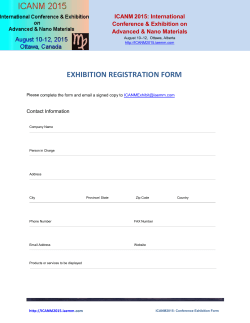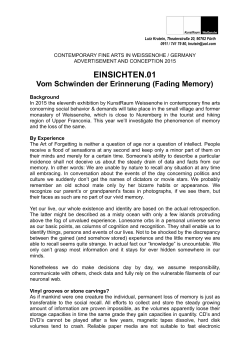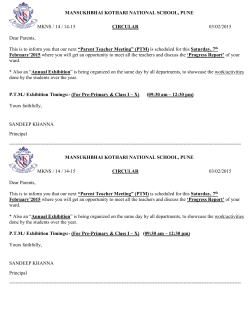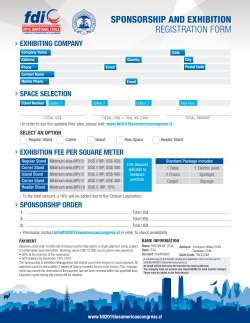
Degas, an Impressionist Painter?
Press Release / March 2015 Degas, an Impressionist Painter? From March 27 th to July 19 th, 2015 This exhibition received exceptional loans from the musée d’Orsay www.mdig.fr Press Release / March 2015 Degas, an Impressionist Painter? Summary 2 Presentation of the exhibition Degas, an Impressionist Painter? 4 Overview of the exhibition 8 Chronological table 10 List of lenders 12 The catalogue of exhibition 16 Press images 20 Permanent exhibit 22 Upcoming exhibition 24 Useful information Rochers au bord d’une rivière, v. 1890 - Pastel sur monotype couleurs à l’huile, 39,8 × 29,8 cm Collection particulière © Tous droits réservés musée des impressionnismes giverny /3 Presentation présentation de of the exhibition l’exposition Le Champ de courses, jockeys amateurs près d’une voiture, entre 1876 et 1887 (détail) Huile sur toile, 65,2 × 81,2 cm, Paris, musée d’Orsay, RF 1980 © RMN-Grand Palais (musée d’Orsay) / Photo : Hervé Lewandowski Press Release / March 2015 Degas, an Impressionist Painter? Degas, an Impressionist Painter? Within the mission of its exhibition policy, which is to explore the different aesthetic forms of impressionism, the musée des impressionnismes Giverny in partnership with the musée d’Orsay will present an exhibition titled “Degas, an Impressionist Painter?” Whereas Edgar Degas is today considered one of the great impressionist artists – he was a diligent participant at the “impressionist exhibitions”, being represented at seven of them – he had a complex relationship with his colleagues and plein air painting, which was a distinctive feature of the impressionist period in the career of many artists. The exhibition will number approximately eighty works, featuring paintings, sculptures, pastels, monotypes and drawings. As part of the collaborative relationship between the musée des impressionnismes Giverny and the musée d’Orsay, the latter will contribute important works to the exhibition. Several museums in America and Europe and a number of important private collectors are also participating. The scientific committee will be formed by Marina Ferretti, Director of Exhibitions and Research at the musée des impressionnismes Giverny, and Xavier Rey, Director of Collections and Curator at the musée d’Orsay. At the end of his life, Degas was keen to point out the distance between his art and that of the impressionists: “If I were the government, I would have a special brigade of gendarmes to keep an eye on the people who paint landscapes from nature…” he is supposed to have confided to Ambroise Vollard. He also had harsh words for Claude Monet, who nonetheless admired the work of his elder colleague very much. For example, standing in front of Monet’s Lilies, he remarked dryly that he did “not feel the need to lose consciousness before a pond”, and told the painter to his face, “I only stayed a moment at your exhibition. Your paintings made me dizzy”. Henceforth, though Degas remained active in the impressionist revolution of the manner in which an artist looked upon his motif, he differentiated himself from his colleagues, introducing in particular a novel attention to scenes lit artificially, and concentrating on more personal motifs, such as bodily movement, which he studied through dance. Le Champ de courses, jockeys amateurs près d’une voiture, entre 1876 et 1887 - This exhibition received exceptional loans from the musée d’Orsay Huile sur toile, 65,2 × 81,2 cm, Paris, musée d’Orsay, RF 1980 © RMN-Grand Palais (musée d’Orsay) / Photo : Hervé Lewandowski musée des impressionnismes giverny /5 Press Release / March 2015 Overview The exhibition of the will be divided exhibition in five main sections Degas, an Impressionist Painter? 1. A classical background Danseuses (Danseuses au repos), v. 1898 (détail) - Pastel sur cinq feuilles de papier contrecollées sur carton, 83 × 72 cm, Lausanne, fondation de l’Hermitage, legs de Lucie Schmidheiny, 1998 © Lausanne, fondation de l’Hermitage / Photo : Giorgio Skory, Romanel-sur-Lausanne A pupil of Barrias and Lamothe, a follower of Hippolyte Flandrin and a great admirer of Ingres, Degas briefly studied at the École des beaux-arts before spending three years in Italy where he had family. An outstanding draughtsman, he was often inspired by Antiquity, the Renaissance and the artists of Bologna. He remained faithful to the traditional procedures of executing a painting: studies of live models, preparatory drawings regarding both composition and details, the use of a grid, etc. Thus, more than most of the other impressionists, he was steeped in a classical culture that he would never forsake. 2. Impressionism in portraiture and scenes of modern life With the exception of the 1882 exhibition, Degas took part in all the impressionist exhibitions from 1874 to 1886. Fearing that they might appear like exhibitions by artists refused by the official Salons, and wishing to give them more credibility, he asked some of his friends whose talent was already recognised, such as the Italian painter Giuseppe De Nittis, to participate. He also introduced the American painter Mary Cassatt into the group. The invasive presence of Degas’s friends (not all of whom had the same talent as either De Nittis or Cassatt) ended by discouraging Monet and Renoir and diluting the quality of the impressionist exhibitions. Furthermore, Degas’s influence on these exhibitions tended to shift the focus away from what was construed as the particular nature of impressionism and in the direction of the more general movement of Naturalism, founded on portraiture and genre scenes, which were already beginning to be celebrated in the official Salons of the Third Republic. Danseuses (Danseuses au repos), v. 1898 - Pastel sur cinq feuilles de papier contrecollées sur carton, 83 × 72 cm, Lausanne, fondation de l’Hermitage, legs de Lucie Schmidheiny, 1998 © Lausanne, fondation de l’Hermitage / Photo : Giorgio Skory, Romanel-sur-Lausanne musée des impressionnismes giverny /6 Organization of the exhibition Degas, an Impressionist Painter? 3. The question of landscape 5. Degas after 1892 “You need the natural life, I the artificial”, Degas is said to have stated to his impressionist colleagues, and it is true that, in his work, he broadly focused on the world of dance, interiors and, more generally, scenes of modern life. However, Degas also left a number of landscapes, in particular a remarkable series of pastels drawn from memory, which he recreated in his studio in 1869 with the help of notes he had made in a sketchbook. In 1890, he returned to the theme of the landscape, as is seen in a series of monotypes highlighted with pastels, almost abstract memories of fleeting visions that he presented at the galerie Durand-Ruel in 1892. But, once again, he seemed to take the opposite approach to his fellowimpressionists by emphasising the mystery of the scenes, as seen in the works of the Symbolists. Degas ended his days withdrawn from the social aspects of the life of an artist and refused to exhibit after 1892. As from the 1880s, the paths of the impressionist painters had diverged and each was working individually, while also digressing from the impressionism of the years 1870–80. During this period, Degas was producing pastel drawings of dancers and nudes from memory, which he described as “orgies of colour”. Very quickly, at the exhibition of his studio works prior to their auction following his death, this approach was to usher in highly modern and avant-garde forms, which would in turn be sources of inspiration for the young artists at the start of the twentieth century, the Fauves and future Cubists. 4. The body in movement The theme of movement, and those particularly of ballet and dance, fascinated Degas. During the Second Empire and the Third Republic, the Opéra and ballet were very fashionable and characteristic aspects of an evening social life which, thanks to the installation of public electric lighting, was taken up by increasing numbers. Fascinated by the effects of artificial lighting on the legs of ballerinas, Degas captured the poses, movements and outfits of the young dancers. He also closely studied the work of the girls as they exercised at the bar during their lessons. The balance of colours in Degas’s works was often decided by the colour of a legging or tutu. For Degas the young dancers, like horses, provided him the opportunity to put scientific discoveries at the service of his art and to give an answer to the challenge offered by the precision of photography, which he had made use of himself. The decomposition of movement rendered by chronophotography encouraged him to tackle highly daring forms in his drawing. Ballet, dit aussi L’Étoile, v. 1876 - Pastel sur monotype, 58,4 × 42 cm Paris, musée d’Orsay, RF 12258 © Paris, musée d’Orsay, Dist. RMN-Grand Palais / Photo : Patrice Schmidt musée des impressionnismes giverny /9 Press Release / March 2015 Edgar Degas Chronological (1834-1917) table 19 July 1834 Birth of Hilaire Germain-Edgar De Gas in Paris. Son of Laurent Pierre Augustin Hyacinthe De Gas, banker, and Marie Célestine Musson. He is given a bourgeois education. Portrait de l’artiste dit Degas au chapeau mou, v. 1857-1858 (détail) - Huile sur papier appliqué sur toile, 26 × 19,1 cm Williamstown, Sterling and Francine Clark Art Institute, 1955.544 © 2008 The Sterling and Francine Clark Art Institute, Williamstown 1855 Visits Jean-Auguste-Dominique Ingres in his studio in the company of collector Édouard Valpinçon. April: he is admitted to the École des beaux-arts as a pupil of the painter Louis Lamothe. 1865 May: first participation at the Salon with Scènes de guerre au Moyen-Âge (Paris, musée d’Orsay). 1868 Spring: frequents the café Guerbois. 1869 July-August: stays on the Normandy coast at Étretat, Villers-sur-Mer and Boulognesur-Mer, where he produces a series of pastel landscapes. 1856-1859 Lives in Italy (Naples, Rome, Florence) where he copies works by Renaissance masters. Gets to know Gustave Moreau. 1870 May: last participation at the Salon, where he presents Madame Théodore Gobillard, (Yves Morisot, 1838-1893) 1860 Second stay in Italy (Naples, Florence). October 1872 – March 1873 Stays with his family in New Orleans. 1873 February: produces two versions of the same subject: Portraits dans un bureau (Nouvelle-Orléans). 1874 First exhibition of the impressionist group. Degas will take part in seven of the eight impressionist group exhibitions, missing only the one in 1872, and will be active in their organization. 1878 March: the musée des Beaux-Arts de Pau purchases Portraits dans un bureau (Nouvelle-Orléans). 1881 He presents the sculpture of the Petite Danseuse de quatorze ans at the fifth impressionist group exhibition. 1886 May: at this, his last impressionist exhibition, he presents a series of female nudes “bathing, washing, drying, wiping themselves or brushing their hair”. Degas, an Impressionist Painter? 1890 September: trip in Burgundy with the sculptor Bartholomé. He executes his first landscapes using the monotype technique. 1892 November: exhibition of landscapes, monotypes and pastels at the galerie Durand-Ruel in Paris. 1896 As a result of the Caillebotte bequest, seven works by Degas enter the musée du Luxembourg. 1897 August: with his friend Bartholomé he visits the Ingres museum in Montauban. 27 septembre 1917 Dies in Paris aged 83. 1888 Summer: he produces sculptures of horses. musée des impressionnismes giverny / 11 List of lenders Press Release / March 2015 We would like to extend our heartfelt thanks to all the collectors whose generous loans have made this exhibition possible: Anisabelle Berès-Montanari Collection André Bromberg Collection E.W.K. Collection James T. Dyke Collection United-States United Kingdom Private collection, courtesy Acquavella Galleries, New York Columbus, Columbus Museum of Art New York, The Metropolitan Museum of Art Pittsburgh, Carnegie Museum of Art Washington, National Gallery of Art Williamstown, Sterling & Francine Clark Art Institute Edinburgh, Scottish National Gallery France Henri Rouart devant son usine, v. 1875 (détail) - Huile sur toile, 65,4 × 50,5 cm Pittsburgh, Carnegie Museum of Art, acquis grâce à la générosité de la famille Sarah Mellon Scaife, 69.44 © Pittsburgh, Carnegie Museum of Art Degas, an Impressionist Painter? Avignon, musée Angladon Le Havre, MuMa musée d’art moderne André Malraux Paris, galerie Berès Paris, lycée Claude-Monet Paris, musée d’Orsay Paris, musée d’Orsay, on deposit at the musée des Beaux-Arts de Nancy Paris, musée Marmottan Monet Paris, Petit Palais, musée des Beaux-Arts de la Ville de Paris Pau, musée des Beaux-Arts Rouen, musée des Beaux-Arts Switzerland Lausanne, Fondation de l’Hermitage Without forgetting the many private lenders who wish to remain anonymous. Henri Rouart devant son usine, v. 1875 - Huile sur toile, 65,4 × 50,5 cm Pittsburgh, Carnegie Museum of Art, acquis grâce à la générosité de la famille Sarah Mellon Scaife, 69.44 © Pittsburgh, Carnegie Museum of Art musée des impressionnismes giverny / 13 Press Release / March 2015 The catalogue Degas, an Impressionist Painter? of exhibition An important catalogue in French will be published as part of this exhibition, with contributions by internationally renowned experts on the art of Degas. All the works exhibited will be illustrated with full-page reproductions. This publication, co-published with Éditions Gallimard, will be distributed throughout France and abroad. Degas, an Impressionist Painter? Catalogue contents: • Forewords by Jean Louis Destans, President of the musée des impressionnismes Giverny, by Frédéric Frank, Director of the musée des impressionnismes Giverny, and by Marina Ferretti, Co-curator of the exhibition and Director of Exhibitions and Research at the musée des impressionnismes Giverny. Femme vue de dos (La Visite au musée), v. 1877-1880 (détail) Huile sur toile, 81,3 × 75,6 cm Washington, National Gallery of Art, collection de M. et Mme Mellon, 1985.64.11 © Washington, National Gallery of Art • Introduction by Guy Cogeval, President of the musées d’Orsay et de l’Orangerie and Vice-president of the musée des impressionnismes Giverny • Preface by Henri Loyrette • Essay by Xavier Rey, Co-curator of the exhibition and Director of Collections and Curator at the musée d’Orsay, “Degas and impressionism: a temperament impervious to a movement” • Essay by Ann Dumas, Curator at the Royal Academy of Arts in London, “Degas: the question of landscape” cover of the catalogue - Version : French Coedition : musée des impressionnismes Giverny and Éditions Gallimard Publication : March 2015 Size : 24 × 29 cm 160 pages Price : 29 euros • Essay by Paul Perrin, Curator at the musée d’Orsay, “There are marvellous coexistences [...] Degas and Renoir” • Essay by Anne Roquebert, Curator at the musée d’Orsay, “Degas versus Monet” • Catalogue of the works exhibited (80 full colour pages with an introduction to each section) • Chronology by Vanessa Lecomte, Associate Curator at the musée des impressionnismes Giverny • Selective bibliography musée des impressionnismes giverny / 14 Exhibition catalogue Marina Ferretti Marina Ferretti is Director of Exhibitions and Research at the musée des impressionnismes Giverny. She has organized many important exhibitions, such as “Signac” (Paris, Grand Palais, Amsterdam, Van Gogh Museum and New York, Metropolitan Museum of Art, 2001), “Le Néoimpressionnisme. De Seurat à Paul Klee” (Paris, musée d’Orsay, 2005), “Le Jardin de Monet à Giverny” (Giverny, musée des impressionnismes, 2009), and “Signac, les couleurs de l’eau” (Giverny, musée des impressionnismes and Montpellier, musée Fabre, 2013). She has written several essays and books on impressionism, including L’Impressionnisme (in the collection “Que sais-je ?”, Paris, PUF, 2004). Xavier Rey Xavier Rey studied at the École normale supérieure in Paris and graduated from HEC. He was appointed Curator at the musée d’Orsay in 2010. Responsible for the exhibition of the permanent painting collections, he was made Director of Collections in 2013 following various phases of the renovation works carried out in the museum since 2011. A specialist in painting, with George Shackelford he was co-curator of “Degas and the Nude” (Boston, Museum of Fine Arts, and Paris, musée d’Orsay, 2011-2012), then of a retrospective of Degas in the collections of the musée d’Orsay in Turin. “Degas, un peintre impressionniste ?” is related to his research on the historiography of impressionism and its presentation in the public collections. Ann Dumas Ann Dumas is Curator at the Royal Academy of Arts in London. She has been responsible for the organization of many exhibitions on the art of the 19th and 20th centuries, in particular “The Private Collection of Edgar Degas” (New York, Metropolitan Museum of Art), “From Cézanne to Picasso: masterpieces from the galerie Vollard” (New York, Metropolitan Museum of Art; Art Institute of Chicago; Paris, musée d’Orsay, 2006-2007), “Degas: The Late Landscapes” (Copenhagen, Ny Carlsberg Glyptotek; Columbus Museum of Art, 2006-2007), “The Real Van Gogh: The Artist and His Letters” (London, Royal Academy of Arts, 2010), and was co-curator of “Degas and the Ballet: Picturing Movement” (London, Royal Academy of Arts, 2011). Degas, an Impressionist Painter? Anne Roquebert Anne Roquebert is Curator and Chargée de mission at the musée d’Orsay. She has been involved in the organization of many exhibitions, most importantly: “Toulouse-Lautrec” (London and Paris, 1991-1992), “From Cézanne to Picasso: masterpieces from the galerie Vollard” (New York, Chicago and Paris, 2006-2007), “Claude Monet” (Paris, 2010-2011). Anne Roquebert has also published articles and books, in particular on Degas (Cercle d’art, 1988; Phenice, 1993) and Toulouse-Lautrec (Hachette-RMN, 1992; Cercle d’art, 1995). She has also contributed to catalogues on the French national collections: Catalogue sommaire illustré du musée du Louvre et du musée d’Orsay, École française (Paris, RMN, 1986); that of the musée d’Orsay in 1990; Catalogue des MNR (Paris, RMN, 2004). Vanessa Lecomte Vanessa Lecomte is Associate Curator at the musée des impressionnismes Giverny where she was co-curator of the exhibitions “Maurice Denis, L’Éternel Printemps” and “Monet intime. Photographies de Bernard Plossu” in 2012. En 2008, she organized the exhibition “Portrait of a Lady” (musée d’Art Américain Giverny; Bordeaux, musée des Beaux-Arts, 2008-2009). She has written contributions to several exhibitions at the musée des impressionnismes Giverny, among which “Le Jardin de Monet à Giverny: l’invention d’un paysage” (2009), “Joan Mitchell, peintures” (2009), “L’Impressionnisme au fil de la Seine” (2010), “Maximilien Luce, néo-impressionniste. Rétrospective” (2010), “Bonnard en Normandie” (2011), and “Hiramatsu Reiji, le bassin aux nymphéas. Hommage à Monet” (2013). Paul Perrin Paul Perrin is Painting Curator at the musée d’Orsay. He is in charge of the organization of several forthcoming exhibitions, among which “Frédéric Bazille, la jeunesse de l’impressionnisme” (Montpellier, musée Fabre; Paris, musée d’Orsay; and Washington, National Gallery of Art, 2016-2017) and an exhibition on the Second Empire (2016). He has written various articles and essays on Renoir and impressionism, and contributed to the realization of the catalogue of the exhibition “Sur la route d’Italie, peindre la nature d’Hubert Robert à Corot” (Évreux, musée d’Art, Histoire et Archéologie; Amiens, musée de Picardie, 2014-2015). Danseuse, grande arabesque, troisième temps, fonte exécutée entre 1921 et 1931 par Adrien Aurélien Hébrard d’après un original en cire réalisé vers 1882-1895 (détail) Statuette en bronze patiné, 40,5 × 56,2 × 31 cm Paris, musée d’Orsay, RF 2071 © RMN-Grand Palais (musée d’Orsay) / Photo : Hervé Lewandowski musée des impressionnismes giverny / 17 Press images Press Release / March 2015 Degas, an Impressionist Painter? These images are only available to illustrate articles about the exhibition and for its duration. All other rights reserved. Maisons au bord de la mer, v. 1869 (détail) - Pastel sur papier chamois, 31,4 × 46,5 cm Paris, musée d’Orsay, RF 31201 © RMN-Grand Palais (musée d’Orsay) / Photo : Hervé Lewandowski musée des impressionnismes giverny / 18 Press images / 19 Sémiramis construisant Babylone, 1861 Huile sur toile, 151 × 258 cm Paris, musée d’Orsay, RF 2207 © RMN-Grand Palais (musée d’Orsay) / Photo : Hervé Lewandowski Press Release / March 2015 Degas, an Impressionist Painter? Maisons au bord de la mer, v. 1869 - Pastel sur papier chamois, 31,4 × 46,5 cm Paris, musée d’Orsay, RF 31201 © RMN-Grand Palais (musée d’Orsay) / Photo : Hervé Lewandowski Portraits dans un bureau (Nouvelle-Orléans), 1873 Rochers au bord d’une rivière, v. 1890 - Portrait de l’artiste dit Degas au chapeau mou, v. 1857-1858 - Pastel sur monotype couleurs à l’huile, 39,8 × 29,8 cm Collection particulière © Tous droits réservés Huile sur papier appliqué sur toile, 26 × 19,1 cm Williamstown, Sterling and Francine Clark Art Institute, 1955.544 © 2008 The Sterling and Francine Clark Art Institute, Williamstown Huile sur toile, 73 × 92 cm Pau, musée des Beaux-Arts, 878.1.2 © RMN-Grand Palais / Photos : Michèle Bellot et Madeleine Coursaget Le Champ de courses, jockeys amateurs près d’une voiture, entre 1876 et 1887 Huile sur toile, 65,2 × 81,2 cm, Paris, musée d’Orsay, RF 1980 © RMN-Grand Palais (musée d’Orsay) / Photo : Hervé Lewandowski Danseuse, grande arabesque, troisième temps, fonte exécutée entre 1921 et 1931 par Adrien Aurélien Hébrard d’après un original en cire réalisé vers 1882-1895 Statuette en bronze patiné, 40,5 × 56,2 × 31 cm Paris, musée d’Orsay, RF 2071 © RMN-Grand Palais (musée d’Orsay) / Photo : Hervé Lewandowski Femme vue de dos (La Visite au musée), v. 1877-1880 Huile sur toile, 81,3 × 75,6 cm Washington, National Gallery of Art, collection de M. et Mme Mellon, 1985.64.11 © Washington, National Gallery of Art Ballet, dit aussi L’Étoile, v. 1876 - Pastel sur monotype, 58,4 × 42 cm Paris, musée d’Orsay, RF 12258 © Paris, musée d’Orsay, Dist. RMN-Grand Palais / Photo : Patrice Schmidt Danseuses (Danseuses au repos), v. 1898 - Pastel sur cinq feuilles de papier contrecollées sur carton, 83 × 72 cm, Lausanne, fondation de l’Hermitage, legs de Lucie Schmidheiny, 1998 © Lausanne, fondation de l’Hermitage / Photo : Giorgio Skory, Romanel-sur-Lausanne Henri Rouart devant son usine, v. 1875 - Huile sur toile, 65,4 × 50,5 cm Pittsburgh, Carnegie Museum of Art, acquis grâce à la générosité de la famille Sarah Mellon Scaife, 69.44 © Pittsburgh, Carnegie Museum of Art musée des impressionnismes giverny musée des impressionnismes giverny / 21 Press Release / March 2015 Degas, an Impressionist Painter? Permanent Claude Monet in the middle exhibit from March 27 th to November 1 st, 2015 In its mounting of thematic or monographic exhibitions, the aim of the musée des impressionnismes is to illustrate a precise moment in the history of impressionism or Postimpressionism and to explicate its developments in France and elsewhere in the world. These artistic movements, which developed during one of the richest periods in the history of French art, remain a source of inspiration for many artists today. Theodore Wendel Brook, Giverny (detail), 1885 - Oil on canvas, 72,4 x 90,5 cm Terra Foundation for American Art, Chicago, Daniel J. Terra Collection, 1987.13 © Terra Foundation for American Art, Chicago Maurice Denis Soleil blanc sur les blés, vers 1914 - Huile sur toile, 29 × 34 cm Giverny, musée des impressionnismes, don de Claire Denis, 2012, MDIG D 2012.6 © Giverny, musée des impressionnismes / Photo : Thierry Leroy Thanks to the loans made by our partners, the musée d’Orsay and Terra Foundation for American Art, we are today able to present, in parallel to our exhibitions, a comprehensive display of works centring on the figure of Claude Monet. Without the extraordinarily innovative research of the patriarch of Giverny, the art of Maurice Denis, Pierre Bonnard and Maximilien Luce would be no more understandable than the works by the American artists in the Giverny colony or the Neoimpressionist painters. The paths for possible exploration are innumerable and open the way to a fascinating programme of exhibitions in the future. Even today, the pond and house at Giverny remain mythical places for many artists. The works presented change each year in accordance with loans received but the theme remains unaltered. Thus, in addition to our temporary exhibitions, each season visitors have the opportunity to admire works on the theme of Monet and his influence. In 2015, within the framework of its policy “Le Temps des Collections”, the musée des Beaux-Arts in Rouen will share the exhibition programme at the musée des impressionnismes Giverny, and the musée Marmottan Monet as well. Joan Mitchell La Grande Vallée IX, 1983-1984 - Huile sur toile, 260 × 260 cm Collection FRAC Haute-Normandie, inv. P 84 09 19, en dépôt au musée des impressionnismes Giverny, MDIG D 2009.2 © Collection Frac Haute-Normandie / Photo : Jacqueline Hyde © Estate of Joan Mitchell musée des impressionnismes giverny / 23 Press Release / March 2015 Degas, an Impressionist Painter? Upcoming Photographing Monet’s Garden: exhibition Five Contemporary Views From July 31 to November 1 st, 2015 Darren Almond Fullmoon Impression, 2011 - Stephen Shore Giverny France, 1982 (détail) - Chromogenic color print, 91,4 × 114,3 cm Courtesy of the artist and 303 Gallery, New York, SS 1546.1 © Stephen Shore, courtesy 303 Gallery, New York C-print, 121 × 121 cm Darren Almond Courtesy Galerie Max Hetzler, Berlin / Matthew Marks Gallery, New York / Jay Jopling, White Cube, London © Darren Almond © Adagp, Paris, 2015 Henri Foucault Serie Vibrations - Giverny, 7 November 2012 Photogram, 49,5 x 38,5 cm Collection of the artist © Henri Foucault © Adagp, Paris, 2015 Claude Monet’s garden in Giverny is probably one of the most photographed subjects in the world. This exhibition offers a completely original look at this famous place through the works of five internationally renowned contemporary photographers. The works of Stephen Shore record the restoration of Monet’s garden between 1977 and 1982. More recently the artists Darren Almond, Elger Esser, Henri Foucault and Bernard Plossu each investigated the garden, its magic and endlessly renewed ephemeral beauties in depth. A source of inspiration, with them the gardens becomes a place of experimentation that intensifies our individual perception of time. The exhibition will draw on approximately 90 photographs of small, medium and large formats. Bernard Plossu Garden of Claude Monet, Giverny, June 2011 - Tirage fresson, 30 × 44,8 cm Collection of the artist on long term loan at the musée des impressionnismes Giverny, MDIG D 2015.1.5 © Bernard Plossu Stephen Shore Giverny, France, 1982 - Chromogenic color print, 91,4 × 114,3 cm Courtesy of the artist and 303 Gallery, New York, SS 1546.1 © Stephen Shore, courtesy 303 Gallery, New York Elger Esser Combray (Giverny II), France (HauteNormandie, 27 Eure), 2010 - Heliogravure, 117 x 133 x 6 cm Private collection © Elger Esser 2010 © Adagp, Paris, 2015 musée des impressionnismes giverny Useful information Admission fee Musée des impressionnismes Giverny 99 rue Claude Monet | 27 620 Giverny T. 02 32 51 94 65 | contact@mdig.fr | www.mdig.fr Ticket for galleries Adult: 7 € Child 12 to 18 / Student: 4,50 € Child 7 to 11: 3 € Visitor with disabilities: 3 € Child under 7: free Open from March 27th to November 1st, 2015 Every day from 10 am to 6 pm Galleries will be closed to the public from July 20th to 30th, 2015 (The Autour de Claude Monet gallery will remain open). Le musée est accessible aux personnes à mobilité réduite. On place: restaurant – tea-room, gift shop-bookstore Free on 1st Sunday of the month Family ticket: Buy 3 tickets get one free child admission Annual Pass: 20 € | Duo Pass: 35 € Audioguide : 3 € Combined tickets * Musée des impressionnismes + Maison et Jardins de Claude Monet Adult: 16,50 € Child 12 to 18 / Student: 10 € Child 7 to 11: 8,50 € Visitor with disabilities: 7 € Child under 7: free Musée des impressionnismes + Musée de Vernon Adult: 9 € Student over 26: 6,50 € Child under 7: free Available to individuals only, no queuing required. Online purchasing available: www.mdig.fr www.fnac.com www.ticketmaster.fr * additional charge for management costs Sémiramis construisant Babylone, 1861 (détail) - Huile sur toile, 151 × 258 cm Paris, musée d’Orsay, RF 2207 © RMN-Grand Palais (musée d’Orsay) / Photo : Hervé Lewandowski Musée des impressionnismes Giverny For further information Please contact: 99 rue Claude Monet BP 18 27620 Giverny France Anne Samson Communications Léopoldine Turbat T : 33 (0) 140 36 84 35 leopoldine@annesamson.com T : 33 (0) 232 51 94 65 F : 33 (0) 232 51 94 67 contact@mdig.fr www.facebook.com/mdig.fr www.mdig.fr This exhibition received exceptional loans from the musée d’Orsay At museum Head of communication Géraldine Brilhault T : 33 (0) 232 51 92 48 g.brilhault@mdig.fr Open from March 27th to November 1st, 2015 Every day from 10 am to 6 pm last admission 5.30 pm Galleries will be closed to the public from July 20th to 30th, 2015 (The Autour de Claude Monet gallery will remain open) rue Rouen Clau de M onet Maison & jardins de Claude Monet <V N1 Maison du tourisme d u Roy ER N ON c h e m i n BONNIÈ RES > 4 bus D1 Vernon 81 Giverny D5 N Sortie 16 Bonnières Sortie 14 A1 14 La Seine 3 D113 En couverture Ballet, dit aussi L’Étoile, v. 1876 (détail) - Pastel sur monotype, 58,4 × 42 cm Paris, musée d’Orsay, RF 12258 © Paris, musée d’Orsay, Dist. RMN-Grand Palais / Photo : Patrice Schmidt A1 A1 3 4 A15 Paris
© Copyright 2025









